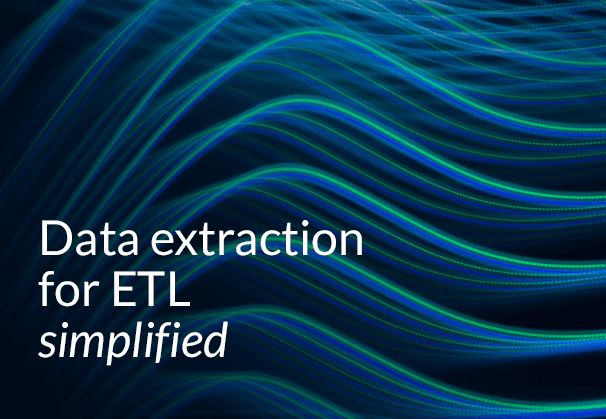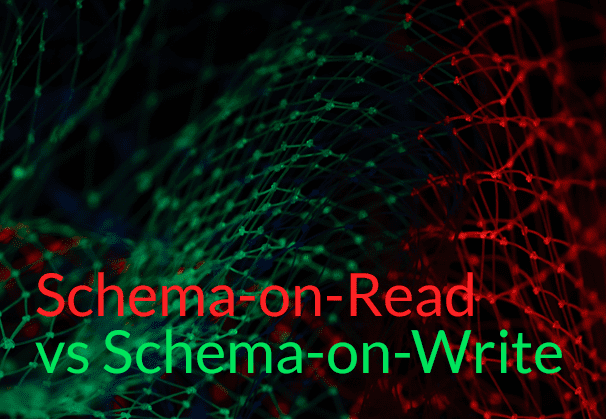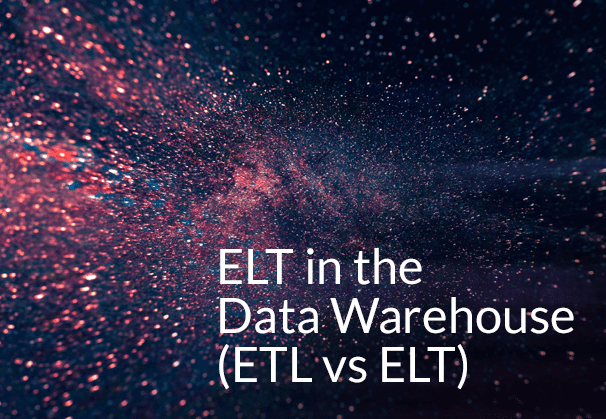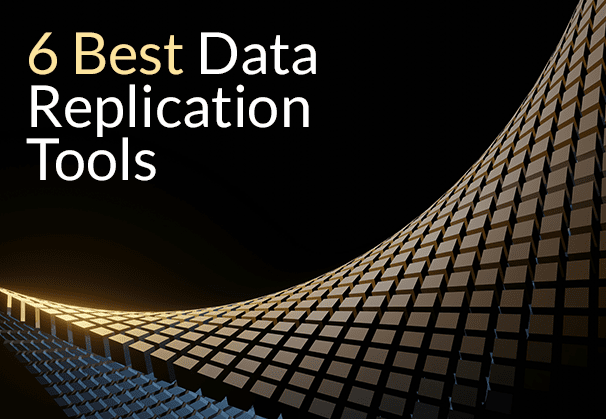What is Data Extraction?
Data extraction refers to the method by which organizations get data from databases or SaaS platforms in order to replicate it to a data warehouse or data lake for Reporting, Analytics or Machine Learning purposes. When data is extracted from various sources, it has to be cleaned, merged and transformed into a consumable format and stored in the data repository for querying. This process is the ETL process or Extract Transform Load.
Data Extraction refers to the ‘E’ of the Extract Transform Load process
Data extraction as the name suggests is the first step of the Extract Transform Load sequence. The process of data extraction involves retrieval of data from various data sources. The source of data, which is usually a database, or files, XMLs, JSON, API etc. is crawled through to retrieve relevant information in a specific pattern. Data ETL includes processing which involves adding metadata information and other data integration processes that are all part of the ETL workflow. How to Select the Right Data Replication Software
The purpose is to prepare and process the data further, migrate the data to a data repository or to further analyse it. In short, to make the most use of the data present. SingleStore DB – Real-Time Analytics Made Easy
Why is Data Extraction so important?
In order to achieve big data goals, data extraction becomes the most important step as everything else is going to be derived from the data that is retrieved from the source. Big data is used for everything and anything including decision making, sales trends forecasting, sourcing new customers, customer service enhancement, medical research, optimal cost cutting, Machine Learning, AI and more. If data extraction is not done properly, the data will be flawed. After all, only high quality data leads to high quality insights. GoldenGate CDC and a better alternative
What to keep in mind when preparing for data extraction during data ETL
- Impact on the source : Retrieving information from the source may impact the source system/database. The system may slow down and frustrate other users accessing it at the time. This should be thought of when planning for data extraction. The performance of the source system shouldn’t be compromised. You should opt for a data extraction approach that has minimal impact on the source. Database Replication Made Easy – 6 Powerful Tools
- Volume : Data extraction involves ingesting large volumes of data which the process should be able to handle efficiently. Analyze the source volume and plan accordingly. Data extraction of large volumes calls for a multi-threaded approach and might also need virtual grouping/partitioning of data into smaller chunks or slices for faster data ingestion.
An Alternative to Matillion and Fivetran for SQL Server to Snowflake Migration - Data completeness : For continually changing data sources, the extraction approach should cater to capture the changes in data effectively, be it directly from the source or via logs, API, date stamps, triggers etc. Kafka CDC and Oracle to Kafka CDC Methods
Automated data extraction: let BryteFlow do the heavy hitting
BryteFlow can do all the thinking and planning to get your data extracted smartly for Data Warehouse ETL. Its ticks all the checkboxes above and is very effective in migrating data from any structured/semi-structured sources onto a Cloud DW or Data Lake. SingleStore DB – Real-Time Analytics Made Easy
Types of Data Extraction
Coming back to data extraction, there are two types of data extraction: Logical and Physical extraction. ELT in Data Warehouse
Logical Extraction
The most commonly used data extraction method is Logical Extraction which is further classified into two categories:
Full Extraction
In this method, data is completely extracted from the source system. The source data will be provided as is and no additional logical information is necessary on the source system. Since it is complete extraction, there is no need to track the source system for changes. Data Migration 101
For e.g., exporting a complete table in the form of a flat file.
Incremental Extraction
In incremental extraction, the changes in source data need to be tracked since the last successful extraction. Only these changes in data will be retrieved and loaded. There can be various ways to detect changes in the source system, maybe from the specific column in the source system that has the last changed timestamp. You can also create a change table in the source system, which keeps track of the changes in the source data. It can also be done via logs if the redo logs are available for the rdbms sources. Another method for tracking changes is by implementing triggers in the source database. Oracle vs Teradata (Migrate in 5 Easy Steps)
Physical Extraction
Physical extraction has two methods: Online and Offline extraction:
Online Extraction
In this process, the extraction process directly connects to the source system and extracts the source data. About Cloud Migration
Offline Extraction
The data is not extracted directly from the source system but is staged explicitly outside the original source system. You can consider the following common structure in offline extraction:
- Flat file: Is in a generic format
- Dump file: Database specific file
- Remote extraction from database transaction logs Debezium CDC Explained and a Great Alternative CDC Tool
There can be several ways to extract data offline, but the most efficient of them all is to do via remote data extraction from database transaction logs. Database archive logs can be shipped to a remote server where data is extracted. This has zero impact on the source system and is high performing. The extracted data is loaded into a destination that serves as a platform for AI, ML or BI reporting, such as a cloud data warehouse like Amazon Redshift, Azure SQL Data Warehouse or Snowflake. The load process needs to be specific to the destination.
Data extraction with Change Data Capture
Incremental extraction is best done with Change Data Capture or CDC. If you need to extract data regularly from a transactional database that has frequent changes, Change Data Capture is the way to go. With CDC, only the data that has changed since the last data extraction is loaded to the data warehouse not the full refresh which is extremely time-consuming and taxing on resources. Change Data Capture enables access of near real-time data or on-time data warehousing. Change Data Capture is inherently more efficient since a much smaller volume of data needs to be extracted. However mechanisms to identify the recently modified data may be challenging to put in place, that’s where a data extraction tool like BryteFlow can help. It provides automated CDC replication so there is no coding involved and data extraction and replication is super-fast even from traditional legacy databases like SAP and Oracle. Change Data Capture Types and Automated CDC
Automated Data Extraction with BryteFlow for Data Warehouse ETL
BryteFlow uses a remote extraction process with Change Data Capture and provides automated data replication with:
- Zero impact on source Oracle vs Teradata (How to Migrate in 5 Easy Steps)
- High performance: multi threaded configurable extraction and loading and provides the highest throughput in the market when compared with competitors BryteFlow as an alternative to Matillion and Fivetran for SQL Server to Snowflake Migration
- Zero coding: for extraction, merging, mapping, masking or type 2 history How to Select the Right Data Replication Software
- Support for terabytes of data ingestion, both initial and incremental Cloud Migration (Challenges, Benefits and Strategies)
- Time series your data Debezium CDC Explained and a Great Alternative CDC Tool
- Self-recovery from connection dropouts Successful Data Ingestion (What You Need to Know)
- Smart catch-up features in case of down-time Database Replication Made Easy – 6 Powerful Tools
- CDC with Transaction Log Replication Kafka CDC and Oracle to Kafka CDC Methods
- Automated Data Reconciliation to check for Data Completeness
Simplify data extraction and integration with an automated data extraction tool
BryteFlow integrates data from any API, any flat files and from legacy databases like SAP, Oracle, SQL Server, MySQL and delivers ready-to-use data to S3, Redshift, Snowflake, Azure Synapse and SQL Server at super-fast speeds. It is completely self-service, needs no coding, and low maintenance. It can handle huge petabytes of data easily with smart partitioning and parallel multi-thread loading.
BryteFlow is ideal for Data Warehouse ETL
BryteFlow Ingest uses an easy-to-use point and click interface to set up real-time database replication to your destination with high parallelism for the best performance. BryteFlow is secure. It is a cloud-based solution that specializes in securely extracting, transforming, and loading your data. As a part of the data warehouse ETL process, if you need to mask sensitive information or split columns on the fly, it can be done with simple configuration using BryteFlow. Learn how BryteFlow Data Replication Software works
Want to know more about easy real-time data extraction and replication? Get a free trial of BryteFlow





